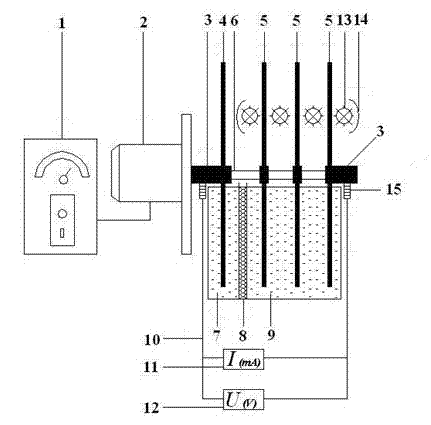Device and method for treating organic wastewater with TiO2 photocatalysis rotary disc fuel cell
A fuel cell and organic wastewater technology, which is applied in the fields of fuel cells, light water/sewage treatment, oxidized water/sewage treatment, etc., can solve the problems of reducing the degradation efficiency of target pollutants, so as to improve the degradation efficiency, reduce the composite loss, improve the The effect of utilization
- Summary
- Abstract
- Description
- Claims
- Application Information
AI Technical Summary
Problems solved by technology
Method used
Image
Examples
Embodiment 10
[0030] TiO monolithic photoanode turntable 2 Photocatalytic turntable fuel cell device for treating organic wastewater.
[0031] A device for treating organic wastewater with a photocatalytic turntable fuel cell, comprising a governor 1, a drive motor 2, a metal rotating shaft 3, a photocathode turntable 4, a photoanode turntable 5, a plexiglass turntable 6, a fuel cell reaction pool and an excitation light source, Wherein the fuel cell reaction cell comprises a photoanode reaction cell 9, a photocathode reaction cell 7 and an ion exchange membrane 8, and the photoanode reaction cell 9 and the photocathode reaction cell 7 are connected by an ion exchange membrane 8, and the ion exchange membrane is a cationic exchange membrane or composite ion exchange membrane. The base material of the photoanode turntable 5 is titanium, stainless steel or nickel, and the material of the photocathode turntable 4 is Cu, Zn, Fe, Ti, Ag, graphite or boron-doped diamond film electrode. Loading ...
Embodiment 11
[0034] Multi-chip series photoanode turntable TiO 2 Photocatalytic turntable fuel cell device for treating organic wastewater.
[0035] A device for treating organic wastewater with a photocatalytic turntable fuel cell, comprising a governor 1, a drive motor 2, a metal rotating shaft 3, a photocathode turntable 4, a photoanode turntable 5, a plexiglass turntable 6, a fuel cell reaction pool and an excitation light source, Wherein the fuel cell reaction cell comprises a photoanode reaction cell 9, a photocathode reaction cell 7 and an ion exchange membrane 8, and the photoanode reaction cell 9 and the photocathode reaction cell 7 are connected by an ion exchange membrane 8, and the ion exchange membrane is a cationic exchange membrane or composite ion exchange membrane. The base material of the photoanode turntable 5 is titanium, stainless steel or nickel, and the material of the photocathode turntable 4 is Cu, Zn, Fe, Ti, Ag, graphite or boron-doped diamond film electrode. L...
Embodiment 1
[0039] Utilization of TiO on different anode substrates 2 A method for treating organic wastewater with a photocatalytic turntable fuel cell.
PUM
 Login to View More
Login to View More Abstract
Description
Claims
Application Information
 Login to View More
Login to View More - R&D
- Intellectual Property
- Life Sciences
- Materials
- Tech Scout
- Unparalleled Data Quality
- Higher Quality Content
- 60% Fewer Hallucinations
Browse by: Latest US Patents, China's latest patents, Technical Efficacy Thesaurus, Application Domain, Technology Topic, Popular Technical Reports.
© 2025 PatSnap. All rights reserved.Legal|Privacy policy|Modern Slavery Act Transparency Statement|Sitemap|About US| Contact US: help@patsnap.com



